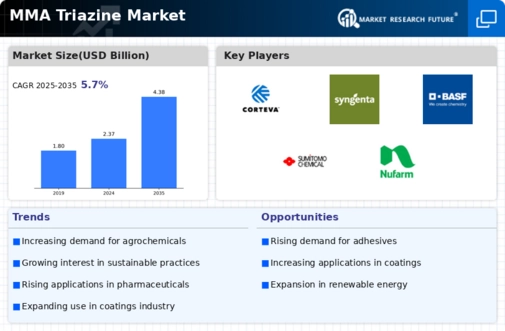The MMA Triazine Market is currently characterized by a dynamic competitive landscape, driven by increasing demand for high-performance materials across various industries, including automotive, construction, and electronics. Key players such as Huntsman Corporation (US), BASF SE (DE), and Evonik Industries AG (DE) are strategically positioned to leverage their extensive product portfolios and technological expertise. Huntsman Corporation (US) focuses on innovation and sustainability, aiming to enhance its product offerings while reducing environmental impact. Meanwhile, BASF SE (DE) emphasizes regional expansion and digital transformation, seeking to optimize its operations and supply chain efficiency. Collectively, these strategies contribute to a competitive environment that is increasingly focused on sustainability and technological advancement.
In terms of business tactics, companies are localizing manufacturing and optimizing supply chains to enhance responsiveness to market demands. The MMA Triazine Market appears moderately fragmented, with several key players exerting influence over pricing and product development. This structure allows for a diverse range of offerings, yet the collective actions of major companies significantly shape market dynamics, often leading to collaborative efforts in research and development.
In August 2025, Huntsman Corporation (US) announced a partnership with a leading technology firm to develop advanced MMA Triazine formulations aimed at improving performance in high-temperature applications. This strategic move underscores Huntsman's commitment to innovation and positions the company to capture emerging market opportunities, particularly in sectors requiring enhanced material properties.
In September 2025, BASF SE (DE) unveiled a new production facility in Asia, designed to increase its capacity for MMA Triazine production. This expansion not only reflects BASF's strategy to meet growing regional demand but also highlights its focus on supply chain optimization. By enhancing local production capabilities, BASF aims to reduce lead times and improve service levels for its customers.
In July 2025, Evonik Industries AG (DE) launched a sustainability initiative aimed at reducing the carbon footprint of its MMA Triazine products. This initiative includes investments in renewable energy sources and the implementation of circular economy principles. Such actions are indicative of Evonik's strategic focus on sustainability, which is becoming increasingly critical in the competitive landscape of the MMA Triazine Market.
As of October 2025, current trends in the MMA Triazine Market are heavily influenced by digitalization, sustainability, and the integration of artificial intelligence in production processes. Strategic alliances among key players are shaping the landscape, fostering innovation and enhancing competitive positioning. Looking ahead, it is likely that competitive differentiation will increasingly pivot from traditional price-based competition to a focus on innovation, technological advancements, and supply chain reliability, as companies strive to meet evolving customer expectations and regulatory demands.

















Leave a Comment